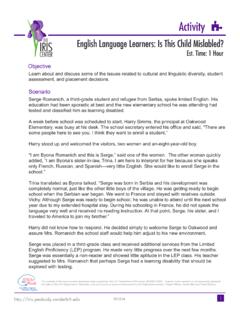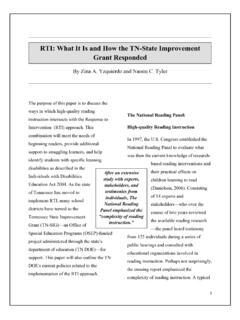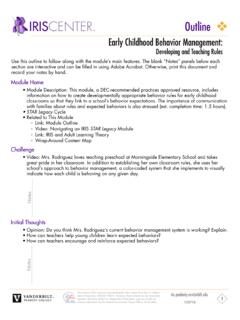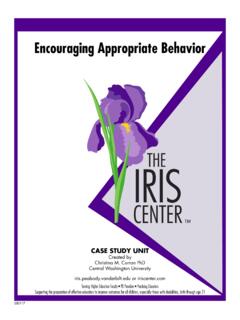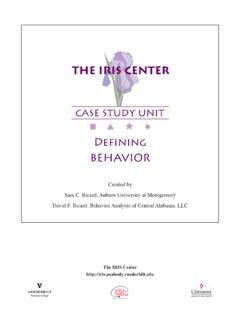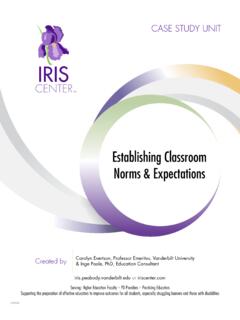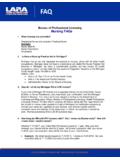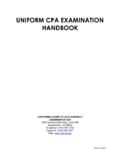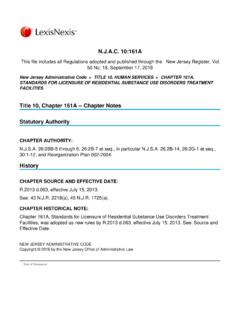Transcription of RTI: Progress Monitoring - Vanderbilt University
1 Or : Higher Education Faculty PD Providers Practicing EducatorsSupporting the preparation of effective educators to improve outcomes for all students, especially struggling learners and those with disabilitiesCASE STUDY UNITC reated byKim Skow, The IRIS Center, Vanderbilt UniversityJanice Brown, PhD., The IRIS Center, Vanderbilt UniversityRTI: Progress contents of this resource were developed under a grant from the Department of Education, #H325E120002. However, those contents do not necessarily represent the policy of the Department of Education, and you should not assume endorse-ment by the Federal Government. Project Officer, Sarah AllenTABLE OF CONTENTSRTI: Progress MonitoringContents: PageCredits ..iiStandards ..iiiIntroduction ..ivSTAR Sheets Progress Monitoring Overview ..1 Administering and Scoring Probes ..4 Graphing.
2 8 Goal Setting and Assessing Student Performance ..12 Communicating with Parents ..15 Case Studies Level A, Case 1 ..17 Level A, Case 2 ..19 Level B, Case 1 ..21 Level B, Case 2 ..23 Level C, Case 1 ..25 Answer Key ..27*For an Instructor s Guide to this case study, please email your full name, title, and institutional affiliation to the IRIS Center at Cite This Case Study UnitBrown, J., Skow, K., & the IRIS Center. (2009). RTI: Progress Monitoring . Retrieved from Contributors Janice BrownKim Skow2009 Case Study DevelopersJanice BrownKim SkowEditorJason MillerReviewersPamela SteckerPam FernstromKim PaulsenGraphicsIRIS CenterRTI: Progress : Progress MonitoringLicensure and Content StandardsThis IRIS Case Study aligns with the following licensure and program standards and topic areas. Council for the Accreditation of Educator Preparation (CAEP)CAEP standards for the accreditation of educators are designed to improve the quality and effectiveness not only of new instructional practitioners but also the evidence-base used to assess those qualities in the classroom.
3 Standard 1: Content and Pedagogical KnowledgeCouncil for Exceptional Children (CEC)CEC standards encompass a wide range of ethics, standards, and practices created to help guide those who have taken on the crucial role of educating students with disabilities. Standard 4: AssessmentInterstate Teacher Assessment and Support Consortium (InTASC)InTASC Model Core Teaching Standards are designed to help teachers of all grade levels and content areas to prepare their students either for college or for employment following graduation. Standard 6: Assessment Standard 10: Leadership and CollaborationsNational Council for Accreditation of Teacher Education (NCATE)NCATE standards are intended to serve as professional guidelines for educators. They also overview the organizational structures, policies, and procedures necessary to support them.
4 Standard 1: Candidate Knowledge, Skills, and Professional case study set is intended to be a supplement to the IRIS Center s RTI Module series, providing additional opportunities to practice the application of basic Progress Monitoring concepts within the response to intervention (RTI) approach. There are two prerequisites for using this case study set. The first is a basic understanding of the RTI approach. If you are unfamiliar with RTI, we recommend that you view the IRIS Module: RTI (Part 1): An OverviewThe second prerequisite is an understanding of Progress Monitoring within the RTI approach. You can learn more about Progress Monitoring by viewing the IRIS Modules: RTI (Part 2): Assessment RTI (Part 4): Putting It All Together Progress Monitoring : Mathematics Progress Monitoring : ReadingKey Ideas Response to intervention is an instructional approach that serves two primary purposes: It provides early intervening services to struggling students as a means through which to improve their skills.
5 It can be used to identify students who have learning disabilities. RTI typically addresses student needs through multiple tiers of increasingly intensive instructional interventions. Whether it is used for early intervening or for the identification of students with learning disabilities, RTI always incorporates the following elements: High-quality instruction ( , instruction based on research-validated practices) Frequent Progress Monitoring Increasingly intense levels of intervention Data-based decision making RTI has many potential benefits, including that: It provides early instructional intervention to those who need it. It requires that teachers rely on assessment data to support their instructional decisions. It reduces inappropriate special education referrals and placements. It accommodates multiple levels of intervention.
6 It increases the use of research-validated instructional practices in the general education classroom. RTI consists of the components outlined in the table : Progress What a STAR Sheet a STAR Sheet STAR (STrategies And Resources) Sheet provides you with a description of a well-researched strategy that can help you solve the case studies in this unit . Universal screeningAll students are given a brief screening measure. This assessment is given one to three times per year ( , fall, winter, and spring). Students at risk for academic failure are 1 Students receive high-quality instruction ( , through validated practices) in the general education setting. Teachers frequently ( , every one to two weeks) monitor the Progress of struggling students who have been identified through the universal screening process. (Note: In some approaches, universal screening is considered to be part of Tier 1.)
7 Tier 2 Students who are not making adequate Progress receive different or additional support from either the classroom teacher or another educational professional. Teachers continue to frequently monitor student 3 Students whose Progress is still insufficient in Tier 2 receive even more intensive and individualized instruction. Depending on a state s or district s policies, this instruction may be provided through general or special the StrategyProgress Monitoring , a type of formative assessment ( , frequent evaluation), is often used to evaluate student learning. Though there are a number of methods for Monitoring a student s Progress , the most widely used is curriculum-based measurement (CBM), the type that will be discussed in this case study Monitoring : Consists of the frequent administration for example, once per week of brief probes or tests ( , one-minute reading passages) that give teachers immediate feedback on the skills currently being taught Uses probes ( , tests) that measure the critical skills that the student must master by the end of the year Allows teachers to assess student learning soon after instruction and to implement instructional changes based on these dataWhat the Research and Resources SayMore than 30 years of research have proven the benefits of Monitoring a student s Progress in reading.
8 Students of teachers who use Progress Monitoring achieve higher grades than do those whose teachers do not (Fuchs, Butterworth, & Fuchs, 1989). Students are more aware of their performance and view themselves as more responsible for their learning when they graph their Progress Monitoring data (Davis, Fuchs, Fuchs, & Whinnery, 1995). Students learn more when teachers implement Progress Monitoring (Safer & Fleischman, 2005). By Monitoring students Progress , teachers can make instructional changes to improve the academic growth of all students, including those who are struggling with reading (Fuchs & Fuchs, 2007). Progress Monitoring data are strongly predictive of student achievement on state and local standardized achievement tests (Good, Simmons, & Kame enui, 2001).Steps for Implementation1. Select appropriate probes ( , tests) for the student s grade and skill level.
9 2. Administer and score the probes at regular intervals ( , weekly, bi-weekly, or monthly). 3. Graph the Set Make instructional decisions based on the Progress Monitoring Communicate Progress with the student, parents, and other education SHEETRTI: Progress MonitoringProgress Monitoring to RTIF requent Progress Monitoring is a key component of each RTI tier (or level). Tier 1: Progress Monitoring probes may be used for the universal screening measure, which identifies students who might be struggling academically. Progress Monitoring is then used to monitor said students for five to eight weeks to determine whether they would benefit from Tier 2 instruction, a more intense and targeted level of instruction. Tier 2: Progress Monitoring is used to determine whether a student is responding adequately to the intervention.
10 Tier 3: In a three-tiered model, when Tier 3 is special education, Progress Monitoring is used to determine whether a student is meeting IEP goals and whether the teacher needs to make instructional changes. Progress Monitoring data can also be used to help determine whether the student could be successful in Tier 1 or Tier in Mind Probes can be administered quickly. Each probe includes sample items reflecting the critical skills in the reading curriculum across the year. Each probe consists of different items or passages of equal difficulty ( , equivalent alternate versions). Teachers can track their students growth throughout the year and make appropriate instructional changes as needed. Progress Monitoring can be implemented with the entire class or with select students. Teachers can also use Progress Monitoring to evaluate the effectiveness of their current instructional methods.




